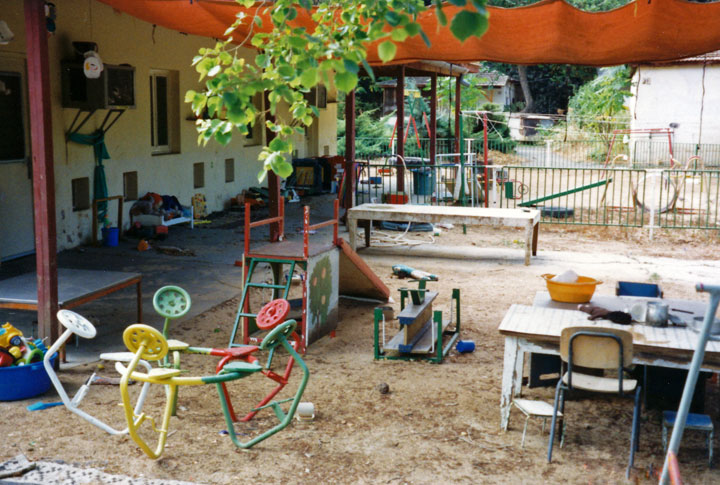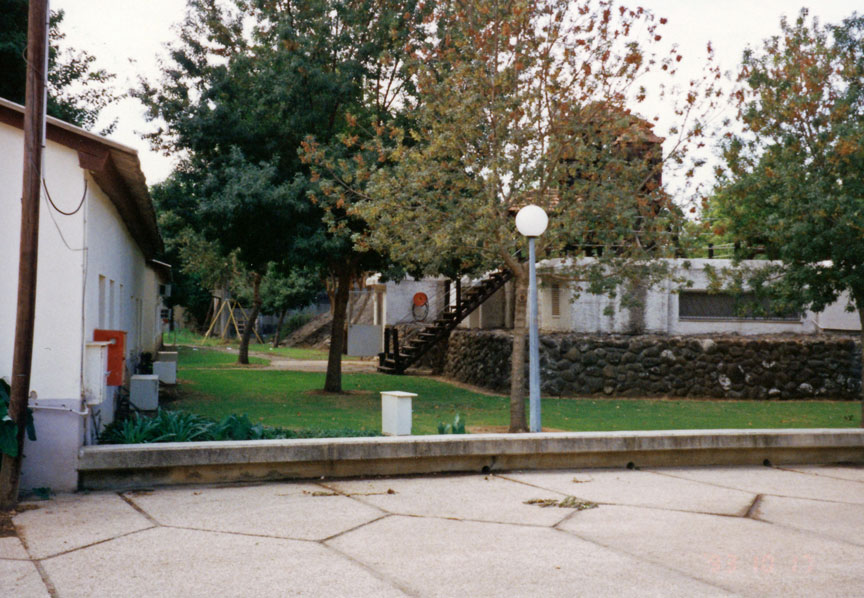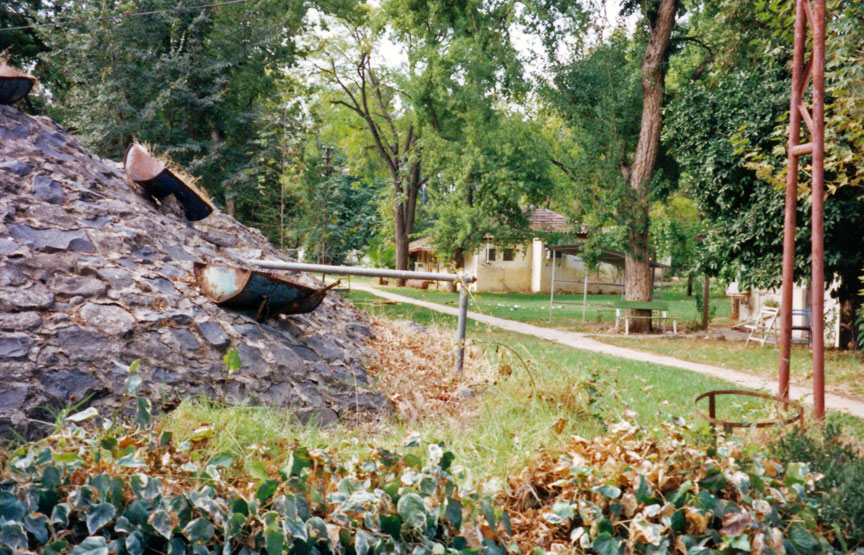

Kibbutz
A kibbutz (Hebrew: קיבוץ, קִבּוּץ,
lit. "gathering, clustering"; plural kibbutzim) is a collective community in
Israel that was traditionally based on agriculture. Today, farming has been
partly supplanted by other economic branches, including industrial plants and
high-tech enterprises. Kibbutzim began as utopian communities, a combination of
socialism and Zionism. In recent decades, many kibbutzim have been privatized
and changes have been made in the communal lifestyle. A member of a kibbutz is
called a kibbutznik (Hebrew: קִבּוּצְנִיק).
Pogroms flared up again in Russia in the first years of the 20th century. In
1903 at Kishinev peasant mobs were incited against Jews after a blood libel.
Riots again took place in the wake of Russia's defeat in the Russo-Japanese War
and the 1905 Revolution. The occurrence of new pogroms inspired yet another wave
of Russian Jews to emigrate. As in the 1880s, most emigrants went to the United
States, but a minority went to Palestine. It was this generation that would
include founders of the kibbutzim.

Klar Blum Kibbutz
Like the members of the First Aliya
who came before them, most members of the Second Aliya wanted to be farmers.
Joseph Baratz, one of the pioneers of the kibbutz movement, wrote a book about
his experiences.
We were happy enough working on the land, but we knew more and more certainly
that the ways of the old settlements were not for us. This was not the way we
hoped to settle the country—this old way with Jews on top and Arabs working for
them; anyway, we thought that there shouldn't be employers and employed at all.
There must be a better way.
Though Baratz and others wanted to farm the land themselves, becoming
independent farmers was not a realistic option in 1909. As Arthur Ruppin, a
proponent of Jewish agricultural colonization of the Trans-Jordan would later
say, "The question was not whether group settlement was preferable to individual
settlement; it was rather one of either group settlement or no settlement at
all."
Ottoman Palestine was a harsh environment. The Galilee was swampy, the Judean
Hills rocky, and the south of the country, the Negev, was a desert. To make
things more challenging, most of the settlers had no prior farming experience.
The sanitary conditions were also poor. Malaria, typhus and cholera were
rampant. Nomadic Bedouins would raid farms and settled areas. Sabotage of
irrigation canals and burning of crops were also common. Living collectively was
simply the most logical way to be secure in an unwelcoming land. On top of
safety considerations, establishing a farm was a capital-intensive project;
collectively the founders of the kibbutzim had the resources to establish
something lasting, while independently they did not.
Finally, the land had been purchased by the greater Jewish community. From
around the world, Jews dropped coins into JNF "Blue Boxes" for land purchases in
Palestine. In 1909, Baratz, nine other men, and two women established themselves
at the southern end of the Sea of Galilee near the Arab village of Umm Juni.
These teenagers had hitherto worked as day laborers draining swamps, as masons,
or as hands at the older Jewish settlements. Their dream was now to work for
themselves, building up the land. They called their community "Kvutzat Degania"
(lit. "wheat of God").
The founders of Degania endured backbreaking labor: "The body is crushed, the
legs fail, the head hurts, the sun burns and weakens," wrote one of the
pioneers. At times half of the kibbutz members could not report for work and
many left. Despite the difficulties, by 1914, Degania had fifty members. Other
kibbutzim were founded around the Sea of Galilee and the nearby Jezreel Valley.
The fall of the Ottoman Empire at the end of World War I, followed by the
arrival of the British, brought with it benefits for the Jewish community of
Palestine and its kibbutzim. The Ottoman authorities had made immigration to
Palestine difficult and restricted land purchases. Rising anti-semitism forced
many Jews to flee Eastern Europe. To escape the pogroms, tens of thousands of
Russian Jews immigrated to Palestine in the early 1920s, in a wave of
immigration that was called the "Third Aliya."
Zionist Jewish youth movements flourished in the 1920s, from right-wing
movements like Betar to left-wing socialist groups such as Dror, Brit Haolim,
Kadima and Habonim (now Habonim Dror). Most significant for the history of the
kibbutz was Hashomer Hatzair, whose members founded many kibbutzim. In contrast
to those who came as part of the Second Aliya, these youth group members had
some agricultural training before embarking. Members of the Second Aliya and
Third Aliya were also less likely to be Russian, since emigration from Russia
was closed off after the Russian Revolution of 1917. European Jews who settled
on kibbutzim between the World Wars were from other countries in Eastern Europe,
including Germany.
In the early days, communal meetings were limited to practical matters, but in
the 1920s and 1930s, they became more informal. Instead of meeting in the dining
room, the group would sit around a campfire. Rather than reading minutes, the
session would begin with a group dance. Remembering her youth on a kibbutz on
the shores of the Kinneret, one woman said: "Oh, how beautiful it was when we
all took part in the discussions, [they were] nights of searching for one
another—that is what I call those hallowed nights. During the moments of
silence, it seemed to me that from each heart a spark would burst forth, and the
sparks would unite in one great flame penetrating the heavens…. At the center of
our camp a fire burns, and under the weight of the hora the earth groans a
rhythmic groan, accompanied by wild songs."

kibbutz defense shelter
Kibbutzim founded in the 1920s tended
to be larger than the kibbutzim like Degania which were founded prior to World
War I. Degania had had twelve members at its founding. Ein Harod, founded only a
decade later, began with 215 members.
Kibbutzim grew and flourished in the 1930s and 1940s. In 1922 there were 700
people living on kibbutzim in Palestine. By 1927, the number had risen to 2,000.
When World War II erupted, 24,105 people were living on 79 kibbutzim, comprising
5% of the Jewish population of Mandate Palestine. In 1950, the figures
went up to 65,000, accounting for 7.5% of the population. In 1989, the kibbutz
population peaked at 129,000.
In 1927, United Kibbutz Movement (HaKibbutz Hameuhad) was established. Several
HaShomer Hatzair kibbutzim banded together to form HaKibbutz HaArtzi. In 1936,
HaKibbutz HaArtzi founded its own political party, the Socialist League of
Palestine, commonly referred to as Hashomer Hatzair.
In 1928 Degania and other small kibbutzim formed "Hever Hakvutzot" ("association
of kvutzot"). Kvutzot were deliberately small, not exceeding 200 members, in the
belief that this was imperative for maintaining trust. Kvutzot did not have
youth-group affiliations in Europe. Kibbutzim affiliated with Hakibbutz Hameuhad
took in as many members as they could. Givat Brenner eventually came to have
more than 1,500 members. Artzi kibbutzim were also more devoted to equality of
the sexes than other kibbutzim. Women called their husbands ishi ("my man")
rather than the customary Hebrew word for husband ba'ali (lit. "my owner"). The
children slept in children's houses and visited their parents only a few hours a
day.
There were also differences in religion. Kibbutz Artzi and Kibbutz HaMeuhad
kibbutzim were secular, even staunchly atheistic, proudly trying to be
"monasteries without God." Most mainstream kibbutzim also disdained the Orthodox
Judaism of their parents, but they wanted their new communities to have Jewish
characteristics nonetheless. Friday nights were still "Shabbat" with a white
tablecloth and fine food, and work was not done on Saturday if it could be
avoided. Only late some kibbutzim adopted Yom Kippur as the day to discuss fears
for the future of the kibbutz. Kibbutzim also had collective bar mitzvahs for
their children.
If kibbutzniks did not pray several times a day, kibbutzniks marked holidays
like Shavuot, Sukkot, and Passover with dances, meals, and celebrations. One
Jewish holiday, Tu B'shvat, the "birthday of the trees" was substantially
revived by kibbutzim. All in all, holidays with some kind of natural component,
like Passover and Sukkoth, were the most significant for kibbutzim.
Religious kibbutzim were established in clusters before the establishment of the
State, creating the Religious Kibbutz Movement. The first religious kibbutz was
Ein Tzurim, founded in 1946.
Arab opposition increased as the Balfour Declaration and the wave of Jewish
aliya to Palestine began to tilt the demographic balance of the area. There were
bloody anti-Arab and anti-Jewish riots in Jerusalem in 1921 and in Hebron in
1929. In the late 1930s Arab-Jewish violence became virtually constant, a period
known as the Great Uprising in Palestinian historiography.
Kibbutzim began to assume a more prominent military role. Rifles were purchased
or manufactured and kibbutz members drilled and practiced shooting. Yigal Allon,
an Israeli soldier and statesman, explained the role of kibbutzim in the
military activities of the Yishuv.
The planning and development of pioneering Zionist were from the start at least
partly determined by politico-strategic needs. The choice of the location of the
settlements, for instance, was influenced not only by considerations of economic
viability but also and even chiefly by the needs of local defense, overall
settlement strategy, and by the role such blocks of settlements might play in
some future, perhaps decisive all out struggle. Accordingly, land was purchased,
or more often reclaimed, in remote parts of the country.
Kibbutzim also played a role in defining the borders of the Jewish state-to-be.
By the late 1930s when it appeared that Palestine would be partitioned between
Arabs and Jews, kibbutzim were established in outlying areas to insure that the
land would be incorporated into the Jewish state. In 1946, on the day after Yom
Kippur, eleven new "Tower and Stockade" kibbutzim were hurriedly established in
the northern part of the Negev to give Israel a better claim to this arid, but
strategically important, region. The Marxist faction of the kibbutz movement,
Kibbutz Artzi, favored a binational state over partition, but advocated free
Jewish immigration, which the Arabs opposed.
Kibbutzniks fought bravely in the 1948 Arab-Israeli War, emerging from the
conflict with enhanced prestige in the nascent State of Israel. Members of
Kibbutz Degania were instrumental in stopping the Syrian tank advance into the
Galilee with homemade gasoline bombs. Maagan Michael, manufactured the bullets
for the Sten guns that won the war. Maagan Michael's clandestine ammunition
factory was later separated from the kibbutz and grew into TAAS (Israel Military
Industries).
The establishment of Israel and flood of Jewish refugees from Europe and the
Arab world presented challenges and opportunities for kibbutzim. The immigrant
tide offered kibbutzim a chance to expand through new members and inexpensive
labor, but it also meant that Ashkenazi kibbutzim would have to adapt to Jews
whose background was far different from their own. Until the 1950s, nearly all
kibbutzniks were from Eastern Europe, culturally different from the Jews of
Morocco, Tunisia, and Iraq. Many kibbutzim hired Mizrahim as laborers but were
less inclined to grant them membership.
Ideological disputes were also widespread. Israel had been initially recognized
by both the USA and the Soviet Union. For the first three years of its
existence, Israel was in the Non-Aligned Movement, but David Ben-Gurion
gradually began to take sides with the West. The question of which side of the
Cold War Israel should choose created fissures in the kibbutz movement. Dining
halls segregated according to politics and a few kibbutzim even saw Marxist
members leave. This controversy cooled once Stalin's cruelty became better known
and once it became clear that the Soviet Union was systematically anti-Semitic.
The disillusionment particularly set in after the Prague Trials in which an
envoy of Hashomer Hatzair in Prague was tried in an anti-Semitic show trial.
Another controversy involved Holocaust reparations from West Germany. Should
kibbutz members turn over income that was the product of a very personal loss?
If Holocaust survivors were allowed to keep their reparation money, what would
that mean for the principle of equality? Eventually, many kibbutzim made this
one concession to inequality by letting Holocaust survivors keep all or a
percentage of their reparations. Reparations that were turned over to the
collective were used for building expansion and even recreational activities.
Kibbutzniks enjoyed a steady and gradual improvement in their standard of living
in the first few decades after independence. In the 1960s, kibbutzim actually
saw their standard of living improve faster than Israel's general population.
Most kibbutz swimming pools date from the good decade of the 1960s.

Kibbutzim also continued to play an outsize role in Israel's defense apparatus.
In the 1950s and 1960s many kibbutzim were in fact founded by an Israel Defense
Forces group called Nahal. Many of these 1950s and 1960s Nahal kibbutzim were
founded on the precarious and porous borders of the state. In the Six-Day War,
when Israel lost 800 soldiers, 200 of them were from kibbutzim. The prestige
that kibbutzniks enjoyed in Israel in the 1960s was reflected in the Knesset.
When only 4% of Israelis were kibbutzniks, kibbutzniks made up 15% of Israel's
parliament.
As late as the 1970s, kibbutzim seemed to be thriving in every way. Kibbutzniks
performed working class, or even peasant class, occupations, yet enjoyed a
middle class lifestyle.
Text from Wikipedia